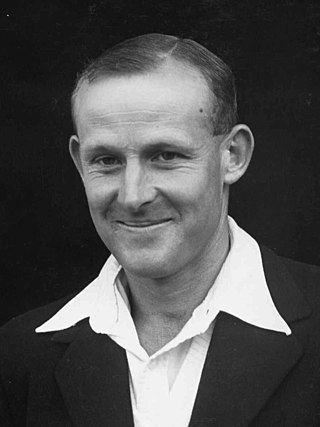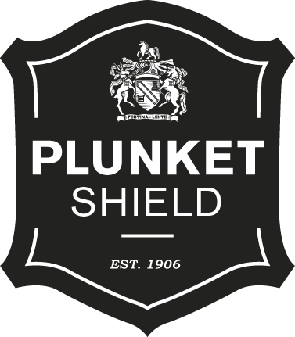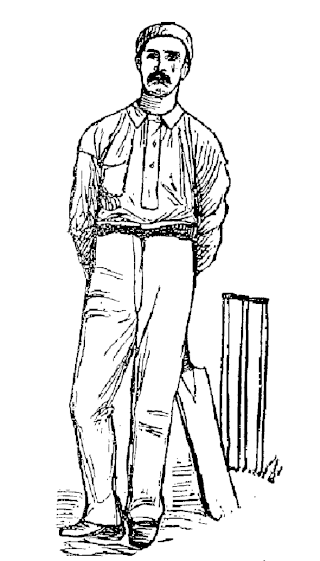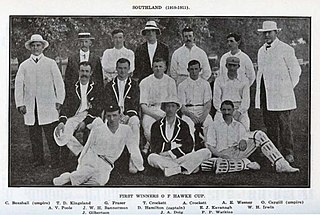
Henry Butler Cave was a New Zealand cricketer who captained New Zealand in nine of his 19 Test matches. His Test career extended from 1949 to 1958, and he played first-class cricket from 1945 to 1959.

Donald Derek Beard was a New Zealand cricketer who played in four Tests from 1952 to 1956. He was a schoolteacher and school principal.

New Zealand has had a domestic first-class cricket championship since the 1906–07 season. Since the 2009–10 season it has been known by its original name of the Plunket Shield.

An English team raised by the Marylebone Cricket Club (MCC) toured New Zealand between December 1906 and March 1907. The tour comprised two first-class matches against New Zealand, two each against the four main provincial teams – Auckland, Canterbury, Otago and Wellington – and one against Hawke's Bay. There were also five minor matches against teams from country areas.

The Hawke Cup is a non-first-class cricket competition for New Zealand's district associations. Apart from 1910–11, 1912–13 and 2000–01 the competition has always been on a challenge basis. To win the Hawke Cup, the challengers must beat the holders, either outright or on the first innings in a drawn match, on the holders' home ground.

William Edward Barton was a New Zealand cricketer who played ten first-class matches for West Coast and Auckland in the 1880s. During his career he was widely considered to be the best batsman in New Zealand.
This article describes the history of New Zealand cricket from the 1918–19 season until 1945.
Ernest Henry Lovell "Bill" Bernau was a New Zealand cricketer who played first-class cricket from 1914–15 to 1927–28, and accompanied the New Zealand national cricket team on their tour of England in 1927.

An Australian team toured New Zealand and Fiji from February to April 1905 to play four first-class matches including two against New Zealand, which had not then attained Test status. Although it was the fifth Australian team to tour New Zealand, it was the first one to play matches on even terms, which therefore have first-class status. On previous tours all matches had been against teams of 15, 18 or 22 players. As well as the two matches against New Zealand, the Australians played first-class matches against Canterbury and Otago. The other games were non-first-class against Auckland, Wellington and Fiji.
The Australia national cricket team toured New Zealand from February to April 1914 and played eight first-class matches including two against the New Zealand national team. New Zealand at this time had not been elevated to Test status. The tour was organized and captained by Arthur Sims, who had previously represented New Zealand. The tour is notable for the fact that it featured Victor Trumper's final appearance in a first-class match before his death at age 37 in 1915.
The Australia national cricket team toured New Zealand from February to April 1928 and played six first-class matches including two against the New Zealand national cricket team. This was before New Zealand began playing Test cricket.
An Australian national cricket team captained by Ian Craig toured New Zealand between February and April 1957. They played 12 matches, seven of which were first-class, including three matches against New Zealand, but these were not granted Test status. The Australians won one and drew two of the international matches, and won the other four first-class matches.

The Southland cricket team represents the Southland Region of New Zealand. They compete in the Hawke Cup.

Reginald John Read was a New Zealand medium-pace bowler who played first-class cricket for Canterbury from 1904–05 to 1937–38.

Daniel Jason McBeath was a New Zealand cricketer who played first-class cricket between the 1917–18 and 1926–27 seasons. He was born at Malvern in the Canterbury Region in 1897.

Chester Arthur Holland was a New Zealand cricketer who played one match for New Zealand in the days before New Zealand played Test cricket.
Thomas Richard Southall was an English-born New Zealand cricketer who played first-class cricket for Wellington from 1913 to 1915.
The Australian cricket team toured New Zealand in January and February 1878, before their 1878 tour of England. It was the first overseas tour by a representative Australian team.
The Australian cricket team toured New Zealand in January and February 1881. The Australians played ten matches against provincial teams, nine of which fielded 22 players with the aim of providing more evenly-matched contests. Two further brief matches were played to fill the allotted time after a scheduled match finished early. As none of the matches were 11-a-side they are not considered to have been first-class.
The New Zealand Under-23 cricket team played 12 matches of first-class cricket in New Zealand between the 1962–63 season and the 1980–81 season.











